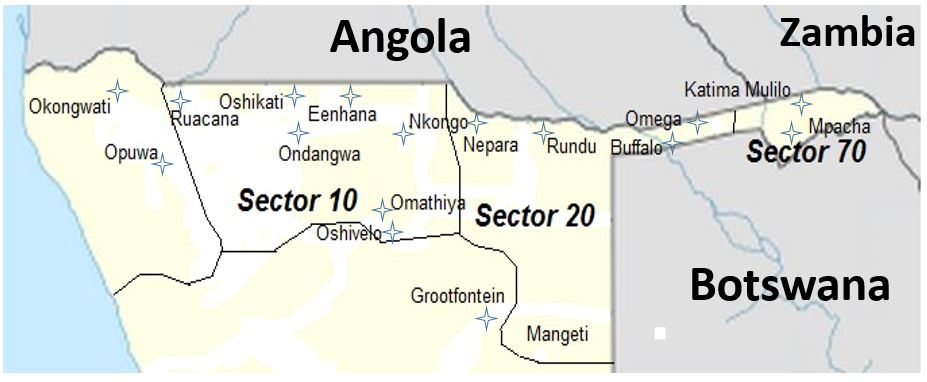101 Battalion (South Africa) on:
[Wikipedia]
[Google]
[Amazon]
101 Battalion (pronounced as ''one-o-one Battalion'') was a quick-reaction unit of the



South West African Territorial Force
The South West Africa Territorial Force (SWATF) was an auxiliary arm of the South African Defence Force (SADF) and comprised the armed forces of South West Africa (now Namibia) from 1977 to 1989. It emerged as a product of South Africa's politic ...
, composed of black and white commissioned and enlisted
Enlisted may refer to:
* Enlisted rank
An enlisted rank (also known as an enlisted grade or enlisted rate) is, in some armed services, any rank below that of a commissioned officer. The term can be inclusive of non-commissioned officers or ...
personnel.
History
Origin
The unit was formed in January 1976 as ''1 Owambo Battalion'', renamed to 35 Battalion in January 1978, 35 Battalion recruited exclusively among the Owambo. and were only given basic training, but this changed after 1978 when the training intensified with an emphasis on rural counterinsurgency operations.Renaming
The South West Africa Territory Force, SWATF renumbered battalion numbers according to their geographical positioning on the border. The prefix 10 pertained to battalions operating to the west of the Kavango River, 20 to the Kavango or central region and 70 to the eastern region. Under this system, 35 Battalion was renamed 101 Battalion in 1980.
Tracking
Until 1980 101 battalion was used as small teams attached to SADF units as trackers and interpreters.Light Infantry
By 1981 101 converted to a light infantry battalion. By 1983 at least 2700 men had been recruited and trained, many converted SWAPO insurgents.Introduction of the Romeo Mike Concept
A significant development in 101's operations occurred during 1982 with the adaption ofKoevoet
Koevoet (, meaning ''crowbar'', also known as Operation K or SWAPOL-COIN) was the counterinsurgency branch of the South West African Police (SWAPOL). Its formations included white South African police officers, usually seconded from the South A ...
tactics to a military context. The Reaction Force concept or Romeo Mike developed into two Special Service Companies (901 and 903) in 1984 and a further two (902 and 904) by 1985. Their purpose was to relentlessly track and surround exhausted insurgents. Once a track was detected, elements of a team would dismount from a Casspir and follow the track at a run with the remainder of the team rested and following in the Casspir, and swapping over with the runners frequently, thus sustaining a fast pursuit of the insurgents. When contact was made, the full team with Casspir would charge in. The Romeo Mikes's other three Casspirs would be close of each other and would also react.
Structure
101 Battalion consisted of: * a HQ, * a support company, * a light workshop, * a training wing, * Special service companies, translating Police tracking concepts to suit Army operations: ** 901 and ** 903 Special Service Companies. These Companies concentrated on external operations and pursuit of infiltrators. Another two reaction force companies was activated, and * a Reconnaissance Wing.
Equipment
Each team in a company had: * 4 XCasspir
The Casspir is a Mine-Resistant Ambush Protected Vehicle that has been in use in South Africa since the 1980s. It is a four-wheeled, four-wheel drive vehicle, used for transport of troops. It can hold a crew of two, plus 12 additional soldiers an ...
s
* 1 X Kwêvoël 50
* 2 X Hispano Suiza 20mm cannons,
* 6 X 50 cal Browning machine guns
* 4 X Light machine guns and
* 4 X 60mm patrol mortars
Engagements
101 Battalions reaction force teams averaged about 200 contacts annually.Heitman,H.R. Modern African Wars(3): South West Africa, Osprey Publishing By 1985 101 Battalion fought under its own command instead of being detached to external units.
Disbandment
101 Battalion was disbanded on 30 June 1989 upon the independence ofNamibia
Namibia (, ), officially the Republic of Namibia, is a country in Southern Africa. Its western border is the Atlantic Ocean. It shares land borders with Zambia and Angola to the north, Botswana to the east and South Africa to the south and ea ...
in 1990-91.
101 Battalion's Colours and Standard were finally laid up in the unit church of 5 Reconnaissance Regiment on 10 April 1990.
Leadership
Decorations awarded to 101 Battalion members
*Rifleman D. Hashihamwenda Honoris Crux Silver *Lieutenant N. Prinsloo Honoris Crux *2 Lieutenant D. Bok Honoris Crux *Corporal J.J. Bronkhorst Honoris Crux *Corporal T. Stander Honoris Crux *Corporal J. Theunissen Honoris Crux *Corporal F. Frederick Honoris Crux *Corporal J.H Steenkamp Honoris Crux *L Corporal Roux Honoris Crux *Rifleman Schoombee Honoris CruxRoll of Honour
* * * * * * * * * * * * * * * * * * * * * * * * * * * * * * * * * * * * * * * * * * * * * * * * * * * * * * * * * * * * * * * * * * * * * * * * * * * * * * * * * * * * * * * * * * * * * * *Notes
See also
*South African Border War
The South African Border War, also known as the Namibian War of Independence, and sometimes denoted in South Africa as the Angolan Bush War, was a largely asymmetric conflict that occurred in Namibia (then South West Africa), Zambia, and Ango ...
References
*Further reading
*Helmoed-Romer Heitman (Author), Paul Hannon (Illustrator), Modern African Wars (3): South-West Africa (Men-At-Arms Series, 242), Osprey Publishing (November 28, 1991) . {{SA Army Units South West Africa Territorial Force Military units and formations of the Cold War Military units and formations of South Africa Military units and formations of South Africa in the Border War Military units and formations established in 1976 Military units and formations disestablished in 1991